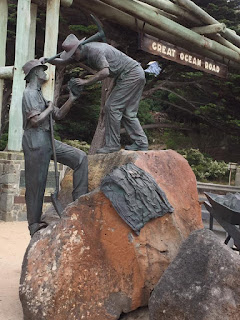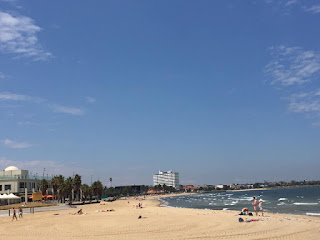MELBOURNE
Melbourne feels like
culture shock after Tasmania! Lots of skyscrapers - modern designs, many quite
artistic - but from my window at the QT Hotel on Russell Street, I see a church
tucked into the cityscape.
A day
tour out of Melbourne to the great Ocean Road included
a stop at the “Great Ocean Road Chocolaterie”. Very busy place! They are obviously getting ready for
the Easter rush!
The Great
Ocean Road started as a project to create work for World War I returned
service men. Eventually, with public and government funding, the road was
completed, and it now links all the coastal towns along it’s 150 mile
stretch. Driving the road is a popular tourist activity BUT requires a
lot of alertness as it hugs the coast. Many of the towns, like Lorne,
host important art and music festivals.
On the Way to the Ocean!
Australia’s gold fields enticed many travelers from around
the world, but many lost their lives on shipwrecks on Shipwreck Coast. This
particular gorge, Loch Ard gorge, shows the beauties and dangers of the
Shipwreck Coast. It is part of the Twelve Apostles Marine National park
of Port Campbell Natonal Park, on the Great Ocean Road.
The rugged coastline which is currently known as the Twelve Apostles was called Ngatanwarr
by the aboriginal peoples, the Kirraewhurrong, who for thousands of years lived
in this rugged coastal environment and figured out how to obtain plentiful
food, shelter, and tools from the land and sea. We are grateful for their
permission to visit country today and see a spectacular sunset vista.
A delightful day with Nick and Helen Apostolidis, former
neighbors in San Francisco!. We headed for the Dandenong Range, about an hour east of Melbourne, which features
winding roads, artist studios, and charming shops and cafés. The thick
temperate rainforest showcases giant ferns and on the way there are lovely
views of rolling grassy hills. A tourist feature is the puffing Billy steam
Railway, which was built in the early 1900s to open up remote areas of the
Australian province of Victoria. Now this narrow gauge railway transports
thousands of tourists yearly for short journeys that are particularly beloved
by children.
St.
Paul’s cathedral, the seat of the Anglican (Episcopal) Church in
the diocese of Melbourne and province of Victoria Australia, is called “the
People’s Cathedral”, because, like Grace Cathedral in San Francisco, it is open
and welcoming to everyone regardless of religion, race, and gender preference.
It was consecrated in 1891. An eye/catching and heart-breaking recent art
installation near the entrance calls attention to the plight of Syrian
refugees; it’s made from life jackets— many of which failed because they were
imitations of the real thing, sold by unscrupulous merchants to desperate
people.
An introductory card available to visitors
notes that the Cathedral stands on the traditional lands of the aboriginal
peoples of the Kulin nation, and affirms the Cathedral’s commitment to the work
of reconciliation.
Nearby Hosier Lane is one of many lanes in Melbourne which are known for outdoor art or murals
NGV
Australia,
in the heart of the city in Federation Square on the banks of the Yarra River,
is an incredible Art and design museum that could clearly occupy several days
of visits. In my few hours there, I concentrated on the collection called
“From Bark to Neon: Indigenous Art from the NGV Collection.” The NGV
(National Gallery of Victoria) no doubt has an incredible collection of
indigenous art. The photos below showcase some of those pieces which
particularly appeal to me. Many pieces are created on bark, and some of the
more modern pieces incorporate neon. I am more of a traditionalist, and I have
included the explanations that are part of the curator commentary on plaques as
you move through the galleries. One aspect of the museum I thought was very
good was that for some art works, there are explanations for children also.
A short walk from NGV is the Koorie Heritage Trust. This is the oldest community owned and run indigenous cultural center in Australia, focusing on the Koorie culture of the province of Victoria. They have a collection of over 95,000 artworks and artifacts, and an active educational program to support and promote the continuing journey of the aboriginal peoples of southeast Australia. Several times a week, they offer an aboriginal walking tour about an hour long, which emphasizes the rich history of aboriginal peoples on the Birrarung Marr (the Yarra River); it’s on my to-do list when I get back to Melbourne in the future.
The Immigration
Museum has many interesting displays of newspapers, posters, photos, and
artifacts regarding the entry of non-aboriginal peoples into Australia. Today,
the citizens of the province of Victoria come from more than 200 countries,
speak 260 languages and dialects, and follow 135 religious faiths. The first
immigrants came unwillingly from Britain as convicts. In the 1830s, free
settlers began to arrive. For aboriginal peoples, it was the beginning of
massive dislocation and distress. Immigration policy in Australia has had a
checkered history, some of it quite racist, but since 1973 multiculturalism is
encouraged – – although overall immigration levels are reduced by law.
Wednesday evenings, thousands of people visit the night market, also known as the Queen
Victoria market. Bands play, vendors sell clothing and services such as
henna hand painting and eyebrow shaping/threading, and of course there’s the
food and the food and the food. And the beer. After all, this is Australia.
Four miles south of Melbourne city center is St Kilda’s beach, the most famous beach
area of Melbourne. I went to see the Penguins who have a colony there. This
particular penguin species, the Little Penguin, has an average height of 1 foot
and is the smallest of the 18 penguin species. They take refuge in the rocks of
the Breakwater pier at St Kilda’s beach to hide from predators. They build
nests in the rocks to raise one or two chicks. The colony here is about 1400
individuals. As you can see from the photo, the penguin I saw was hiding in his
rocky nest to moult , which is part of their yearly cycle.
St Kilda’s is a popular beach that is much used, and provides stunning views of Melbourne. Since there is so much to do in the city of Melbourne, sometimes it is difficult to remember that Melbourne is a big port city. Not far from the beach is an area known for its restaurant and cafés, and perhaps most importantly, its cake shops.
A visit to the Melbourne Museum. Again, another museum you can spend days at, but
this time the focus is on natural history and anthropology, plus the history of
Melbourne itself. Among the items in the Gallery devoted to aboriginal
culture of the region was a photo of a woven eel trap, as eels were an
important source of food treasured for both their protein and fat content.
Smallpox and other diseases introduced by white explorers decimated much of the
aboriginal population in this region of Australia, as elsewhere. Other
galleries in the museum were devoted to Polynesia and Papua New Guinea. The
gallery with artifacts and photos and films about the history of Melbourne made
me realize that it is much like the history of San Francisco – – gold rush and
all.
Farewell to the Antipodes, for now at least.
Just enough time for a quick trip to the roof bar of my hotel, to enjoy a
wonderful warm and sunny day in Melbourne. Rooftop bars are common in the city,
and the outdoor life is important to people who live and work here. 

Nice to be back in the USA. 6:45 sunrise over Los Angeles.
To see the trip to Tasmania, which preceded
this short visit to Melbourne, click here























































